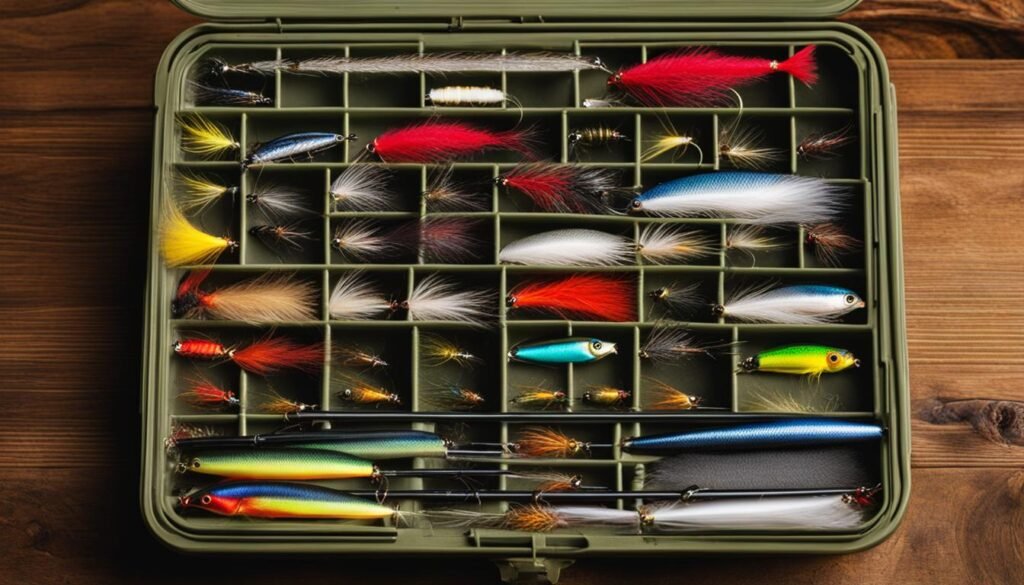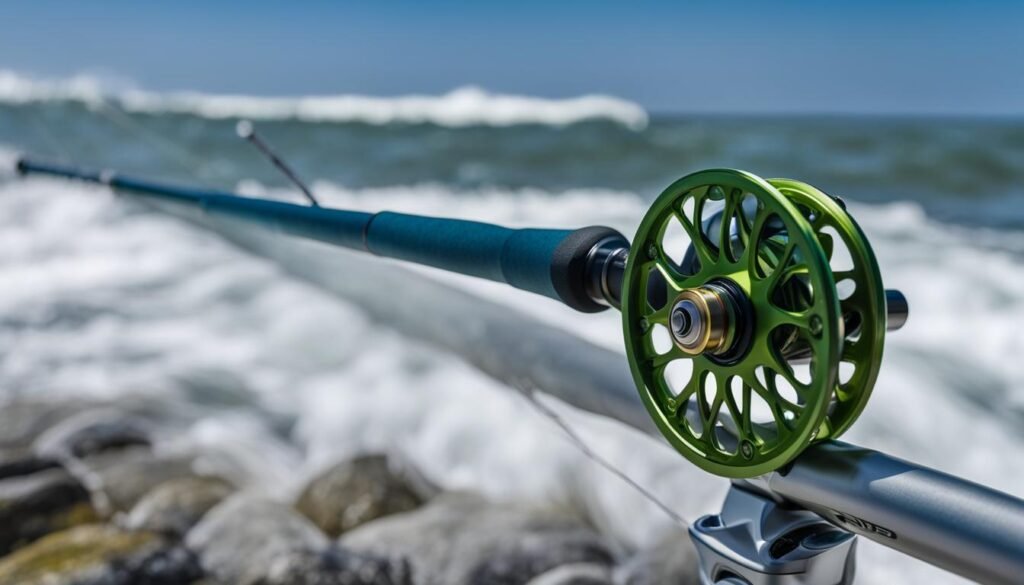If you’re a fan of saltwater fly fishing, you’re in the right place. In this comprehensive guide, we’ll take you through everything you need to know about saltwater flies, saltwater fly fishing, and the different saltwater fly patterns that can help you reel in the big catch.
Saltwater fly fishing is an exhilarating sport that allows you to imitate the natural prey of fish in saltwater environments. Whichever saltwater species you are targeting, using the right flies is essential to attract and hook your desired catch.
Types of Flies for Fly Fishing
Saltwater fly fishing offers a diverse range of fly patterns to choose from, each designed to imitate specific types of prey and attract different species of fish. Understanding the different types of flies used in saltwater fly fishing can greatly enhance your chances of success on the water.
Dry Flies
Dry flies are designed to imitate insects and other food items that float on the water’s surface. These flies are commonly used when fish are actively feeding on top and are particularly effective for species like bonefish and tarpon. Dry flies imitate the natural movement of insects, making them an enticing target for hungry fish.
Wet Flies
Wet flies are designed to mimic insects as they swim towards the water’s surface. These flies are typically fished below the water’s surface and can imitate a wide range of prey items. Wet flies are versatile and can be used to target a variety of saltwater species, including trout, redfish, and snook.
Nymphs
Nymph flies imitate young insects as they emerge from the larval stage and feed close to the bottom of lakes, rivers, and streams. These flies are typically weighted to sink quickly and are often fished using techniques like nymphing or dredging. Nymphs are effective for catching species like steelhead, salmon, and bonefish.
Streamers
Streamers imitate larger prey items such as crayfish, baitfish, and leeches. These flies are typically larger and have more movement in the water to attract predatory fish. Streamers are commonly used for species like striped bass, pike, and muskie. Their lifelike appearance and enticing movement make them a go-to choice for many saltwater fly anglers.
| Types of Flies | Suitable Species |
|---|---|
| Dry Flies | Bonefish, Tarpon |
| Wet Flies | Trout, Redfish, Snook |
| Nymphs | Steelhead, Salmon, Bonefish |
| Streamers | Striped Bass, Pike, Muskie |
Best Fly Patterns for Saltwater Fly Fishing
When it comes to saltwater fly fishing, choosing the right fly pattern is essential for a successful catch. The best fly pattern for saltwater fly fishing depends on the style of fishing and the target species. Different flies are designed to imitate specific types of prey that fish catch in marine habitats, such as crustaceans and other marine creatures.
Dry flies are ideal for surface-feeding fish and imitate insects that exist on the water’s surface. Nymphs, on the other hand, imitate young insects and are a good option for going deeper in the water. Streamers mimic larger prey like minnows and leeches, making them effective for catching predatory fish. Popper flies, with their realistic movement in the water, are particularly suitable for bass fishing. The choice of fly pattern can significantly impact success in saltwater fly fishing, so it’s important to select the right fly based on the fishing conditions and the behavior of the target species.
To give you a better understanding of the different fly patterns available for saltwater fly fishing, here’s a table detailing some of the most popular options:
| Fly Pattern | Target Species | Fishing Technique |
|---|---|---|
| Dry Flies | Surface-feeding fish | Sight fishing |
| Nymphs | Fish feeding closer to the bottom | Deepwater fishing |
| Streamers | Predatory fish | Stripping or retrieving |
| Popper Flies | Bass and other topwater fish | Popping action |
As you can see, each fly pattern serves a specific purpose and can be used in different fishing situations. By understanding the characteristics of each fly pattern and the behavior of your target species, you can make an informed choice and increase your chances of a successful catch in saltwater fly fishing.
Seasonal Flies for Saltwater Fly Fishing

When it comes to saltwater fly fishing, understanding the seasonal hatches and using the right fly patterns can greatly enhance your chances of success. Different seasons bring different types of prey, and knowing which flies to use during each season is essential. Below is a breakdown of the most effective seasonal flies for saltwater fly fishing.
Spring
- Shrimp patterns: Shrimp are abundant during the spring months, making them a prime target for many saltwater fish species. Flies that imitate shrimp, such as the Gotcha fly, are highly effective during this season.
- Crab patterns: Crabs are another popular prey item in saltwater environments. Patterns like the Merkin crab fly and the Del Brown permit crab are excellent choices for targeting fish that feed on crabs.
Summer
- Baitfish patterns: Baitfish are plentiful during the summer, attracting a wide range of predatory fish. Flies that imitate small baitfish, like the Clouser Minnow and the Deceiver fly, are proven to be successful during this season.
- Panfish patterns: Summer is also a great time to target panfish species like snook and redfish. Flies that resemble small panfish, such as the EP baitfish fly and the Gurgler fly, can entice these fish into biting.
Fall
- Mullet patterns: Mullet are highly prevalent during the fall months, and many saltwater fish species feed heavily on them. Flies like the Mullet fly and the Mullett Minnow are excellent choices for imitating mullet and attracting fish during this season.
- Bunker patterns: Bunker, also known as menhaden, are another common prey item in saltwater environments. Flies that imitate bunker, such as the Bob’s Bunker fly and the Bunker fly, are effective for targeting fish that feed on these small fish.
Winter
- Crustacean patterns: Crustaceans like shrimp and crabs are still present in saltwater environments during the winter, providing a viable food source for fish. Flies that mimic crustaceans, such as the Crazy Charlie fly and the Kwan fly, can be productive during this season.
- Minnow patterns: While many species slow down during the winter months, some predatory fish still actively feed on small minnows. Flies like the Glass Minnow fly and the Surf Candy fly can be effective for imitating minnows and enticing fish to strike.
Choosing the Right Fly for Saltwater Fly Fishing
When it comes to saltwater fly fishing, choosing the right fly is essential for a successful fishing trip. The type of fish you are targeting will determine the fly pattern you should use. Whether you are going after fish that lurk close to the bottom of the water or those that feed on the water’s surface, there is a fly that will attract their attention.
If you are targeting fish that feed close to the bottom, nymphs are an excellent choice. These flies imitate young insects and are designed to sink to the depths where these fish typically reside. On the other hand, if you want to entice fish to the water’s surface, dry flies are your best bet. These flies mimic insects that are floating on the water’s surface and are irresistible to surface-feeding fish.
Another option to consider is using attractor flies. These flies are known for their bright colors and patterns that grab the attention of fish. While they may not resemble any specific natural insect, they are great for encouraging fish to bite. Finally, if you are targeting predatory fish, streamer flies are the way to go. These flies closely mimic living creatures like minnows and leeches and are irresistible to larger fish.
Saltwater Fly Tying and Fishing Equipment
When it comes to saltwater fly fishing, having the right equipment is essential for a successful and enjoyable experience. Saltwater fly tying allows anglers to create their own custom flies, tailored to the specific conditions and target species. This not only adds a personal touch to your fishing gear but also gives you the freedom to experiment with different patterns and materials.
To start fly tying, you’ll need a few basic tools such as a vise, bobbin, scissors, and a variety of hooks and materials. A good vise will securely hold your hook while you tie the fly, allowing for precise and accurate work. Scissors with sharp blades are crucial for cutting materials cleanly, while a bobbin ensures smooth and controlled thread tension. Additionally, having a diverse selection of hooks and materials will give you the flexibility to tie different fly patterns based on your fishing needs.
| Equipment | Price Range |
|---|---|
| Saltwater Fly Tying Tools | $50 – $200 |
| Fly Tying Materials | $10 – $50 (per pack) |
| Saltwater Fly Rod and Reel Combo | $200 – $800+ |
| Fly Line | $50 – $100 |
| Leaders and Tippets | $5 – $20 (per pack) |
Choosing the Right Saltwater Fly Rod

Along with selecting the right fly, it’s important to have the appropriate saltwater fly rod. A good-quality rod will make your casting more accurate and your fishing experience more enjoyable. When choosing a fly rod, consider the weight and length that is best suited for the type of fishing you plan to do.
If you are targeting larger fish or fishing in windy conditions, a heavier rod with a higher weight rating, such as 9 or 10 weight, is recommended. This will give you the power and control needed to handle these types of fishing situations. For smaller fish or in calmer conditions, a lighter rod with a lower weight rating, such as 6 or 7 weight, may be more suitable.
In addition to the weight, the length of the rod is also important. Longer rods, around 9 feet in length, provide better line control and casting distance, while shorter rods, around 7 or 8 feet, are more maneuverable in tight spaces. Consider the fishing conditions and your personal preference when selecting the length of your saltwater fly rod.
When investing in saltwater fly fishing equipment, it’s important to find a balance between quality and cost. While high-end equipment can offer advanced features and enhanced performance, more affordable options can still provide excellent value and functionality.

